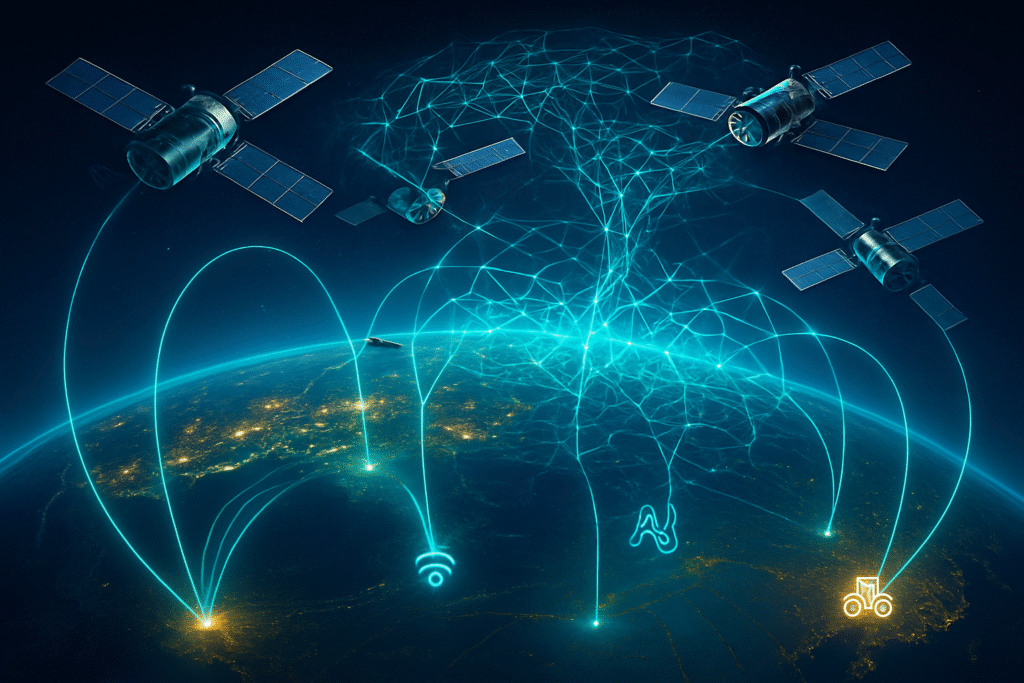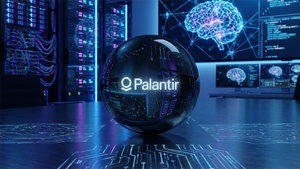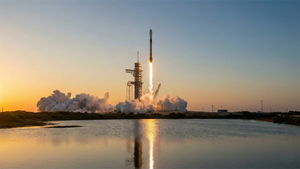Financial News
LEO Satellite IoT Breakthrough: Unmodified Devices Go Global with Nordic Semiconductor, Sateliot, and Gatehouse Satcom

Oslo, Norway – October 9, 2025 – In a monumental leap for global connectivity, a groundbreaking collaboration between Nordic Semiconductor (OSL: NOD), Sateliot, and Gatehouse Satcom has successfully demonstrated the world's first-ever 5G IoT transmission between a standard commercial cellular IoT device and a Low Earth Orbit (LEO) satellite. This achievement, announced on October 8th and 9th, 2025, heralds a new era of ubiquitous, reliable, and affordable connectivity for the Internet of Things (IoT), promising to extend coverage to the approximately 80% of the Earth's surface currently unreached by terrestrial networks. The breakthrough means that millions of existing and future IoT devices can now seamlessly connect to space-based networks without any hardware modifications, transforming Sateliot's LEO satellites into "cell towers in space" and unlocking unprecedented potential for remote monitoring and data collection across industries.
This pivotal development is set to democratize access to IoT connectivity, enabling a vast array of applications from smart agriculture and asset tracking to environmental monitoring and critical infrastructure management in the most remote and hard-to-reach areas. By leveraging standard cellular IoT technology, the partnership has eliminated the need for specialized satellite hardware, significantly lowering the cost and complexity of deploying global IoT solutions and reinforcing Europe's leadership in satellite-based telecommunications.
Unpacking the Technical Marvel: 5G IoT from Orbit
The core of this unprecedented achievement lies in the successful demonstration of a 5G Narrowband IoT (NB-IoT) system operating over an S-band Non-Geostationary Orbit (NGSO) satellite. This end-to-end solution was rigorously validated in full compliance with the 3GPP 5G NB-IoT Release 17 standard, a critical benchmark that extends terrestrial mobile standards into space. This ensures that satellites are no longer isolated communication silos but integral parts of the broader 5G ecosystem, allowing for unified global networks and seamless interoperability.
At the heart of this technical marvel is Nordic Semiconductor's (OSL: NOD) nRF9151 module. This low-power cellular IoT System-in-Package (SiP) module is optimized for satellite communication and boasts industry-leading battery life. Crucially, devices equipped with the nRF9151 module can transmit and receive data over Sateliot's LEO constellation without requiring any hardware alterations. This "unmodified cellular device" capability is a game-changer, as it means the same device designed for a terrestrial cellular network can now automatically roam and connect to a satellite network when out of ground-based coverage, mirroring the familiar roaming experience of mobile phones.
Gatehouse Satcom played an indispensable role by providing its specialized 5G satellite communications software, the "5G NTN NB-IoT NodeB." This software is purpose-built for Non-Terrestrial Network (NTN) environments, rather than being an adaptation of terrestrial solutions. It is engineered to manage the complex dynamics inherent in LEO satellite communications, including real-time Doppler compensation, precise timing synchronization, mobility management, and intelligent beam management. Gatehouse Satcom's software ensures strict adherence to 3GPP standards, allowing satellites to function as base stations within the 5G framework and supporting connectivity across various orbits and payload modes.
This breakthrough fundamentally differentiates itself from previous satellite IoT solutions in two key aspects: device modification and standardization. Historically, satellite IoT often relied on proprietary, specialized, and often expensive hardware, creating fragmented networks. The new solution, however, leverages standard commercial cellular IoT devices and is fully compliant with 3GPP 5G NB-IoT Release 17 for NTN. This adherence to an open standard ensures interoperability, future-proofing, and significantly lowers the entry barriers and costs for IoT deployments, effectively merging the ubiquitous reach of satellite networks with the cost-efficiency and widespread adoption of cellular IoT.
Reshaping the AI and Tech Landscape
The advent of ubiquitous LEO satellite IoT connectivity is poised to profoundly impact AI companies, tech giants, and startups, ushering in a new era of global data accessibility and intelligent automation. For AI companies, this means an unprecedented influx of real-time data from virtually any location on Earth. Low latency and higher bandwidth from LEO constellations will feed richer, more continuous data streams to AI models, significantly improving their accuracy and predictive capabilities. This will also enable the expansion of Edge AI, allowing for faster decision-making for AI-powered devices in remote environments crucial for applications like autonomous vehicles and industrial automation.
Tech giants, particularly those investing heavily in LEO constellations like SpaceX's (Starlink) and Amazon's (NASDAQ: AMZN) Project Kuiper, stand to solidify their positions as foundational infrastructure providers. These companies are building massive LEO networks, aiming for global coverage and directly competing with traditional internet service providers in remote areas. Through vertical integration, companies like Amazon can seamlessly merge LEO connectivity with their existing cloud services (AWS), offering end-to-end solutions from satellite hardware to data processing and AI analytics. This control over the connectivity layer further enhances their data collection capabilities and subsequent AI development, leveraging vast datasets for advanced analytics and machine learning.
For startups, the LEO satellite IoT landscape presents a dual scenario of immense opportunity and significant challenge. While building and launching LEO constellations remains capital-intensive, startups can thrive by focusing on niche innovation. This includes developing specialized IoT devices, advanced AI algorithms, and vertical-specific solutions that leverage LEO connectivity. Partnerships with established LEO operators will be crucial for accessing infrastructure and market reach. Startups that innovate in edge AI and data analytics, processing LEO IoT data onboard satellites or at the network edge to reduce bandwidth and accelerate insights, will find significant opportunities. This development also disrupts existing products and services, as LEO satellite IoT offers a cost-effective alternative to terrestrial networks in remote areas and superior performance compared to older GEO/MEO satellite services for many real-time IoT applications.
Industries set to benefit immensely from this development include agriculture (Agritech), where AI can optimize farming with real-time data from remote sensors; maritime and logistics, enabling global tracking and predictive maintenance for supply chains; mining and oil & gas, for remote monitoring of operations in isolated locations; and environmental monitoring, providing crucial data for climate change research and disaster response. Companies like John Deere (NYSE: DE), for instance, are already integrating satellite communications for remote diagnostics and machine-to-machine communication in their farming machinery, showcasing the tangible benefits.
A New Frontier in Global Connectivity and AI
This LEO satellite IoT connectivity breakthrough signifies a profound shift in the broader technological landscape, deeply intertwining with current global connectivity and AI trends. It represents a critical step towards truly ubiquitous connectivity, ensuring that devices can communicate regardless of geographical barriers. As a core component of 5G Non-Terrestrial Networks (NTN), it integrates seamlessly into the evolving 5G architecture, enhancing coverage, improving reliability, and offering resilient services in previously unserved regions. This development accelerates the trend towards hybrid networks, combining LEO, MEO, GEO, and terrestrial cellular networks to optimize cost, performance, and coverage for diverse IoT use cases.
The most significant impact on the AI landscape is the enablement of massive data collection. LEO satellite IoT unlocks unprecedented volumes of real-time data from a global footprint of IoT devices, including vast geographical areas previously considered "connectivity deserts." This continuous stream of data from diverse, remote environments is invaluable for training and operating AI models, facilitating informed decision-making and process optimization across industries. It drives more comprehensive and accurate AI insights, accelerating progress in fields like environmental monitoring, logistics optimization, and disaster prediction. This milestone can be compared to the early days of widespread internet adoption, but with the added dimension of truly global, machine-to-machine communication fueling the next generation of AI.
However, this transformative technology is not without its challenges and concerns. Regulatory aspects, particularly spectrum management, are becoming increasingly complex as demand for satellite communication intensifies, leading to potential scarcity and interference. Companies must navigate a labyrinth of national and international licensing and compliance frameworks. Security is another paramount concern; the proliferation of gateways and a massive number of terminals in LEO satellite communication systems expands the attack surface, making them vulnerable to cyber threats. Robust cybersecurity measures are essential to protect data privacy and system integrity.
Environmentally, the exponential increase in LEO satellites, particularly mega-constellations, raises serious concerns about orbital debris. The risk of collisions, which generate more debris, poses a threat to operational satellites and future space missions. While regulations are emerging, such as the FCC's requirement for non-functional LEO satellites to deorbit within five years, global coordination and enforcement remain critical to ensure the sustainability of space.
The Road Ahead: An Increasingly Connected World
The near-term future of LEO satellite IoT connectivity is marked by rapid expansion and deeper integration. Forecasts predict a significant increase in LEO satellites, with some estimates suggesting a rise from 10,000 in 2024 to over 24,000 by 2029, with LEOs constituting 98% of new satellite launches. This proliferation will lead to enhanced global coverage, with LEO networks expected to provide 90% global IoT coverage by 2026. Cost reduction through miniaturization and CubeSat technology will make satellite IoT solutions increasingly economical for widespread deployment, while further integration of 5G with satellite networks will solidify direct-to-device (D2D) connectivity for unmodified cellular IoT devices.
In the long term, the landscape will evolve towards multi-orbit and hybrid networks, combining LEOs with GEO satellites and terrestrial 5G/fiber networks to optimize for diverse IoT use cases. Artificial intelligence and machine learning will be increasingly embedded in satellite systems, both in orbit and in ground control, to optimize performance, manage traffic, and ensure efficient use of orbital resources. Experts also predict the rise of edge computing in space, moving processing power closer to devices to reduce transmission costs and enable remote control. Beyond 5G, satellite constellations will play a crucial role in supporting space-based 6G networks, managing data in space, and seamlessly integrating even more devices globally.
New applications on the horizon are vast, ranging from hyper-precision agriculture and enhanced maritime logistics to real-time environmental monitoring and advanced disaster response systems. Remote healthcare will bridge gaps in underserved regions, while critical infrastructure monitoring will provide consistent data from isolated assets. Autonomous vehicles and drones will gain real-time, global communication capabilities, even enabling the exploration of "Deep Space IoT" for lunar or Martian missions.
However, challenges remain, including managing massive connectivity with high signaling overhead, handling the high mobility and frequent handovers of LEO satellites, and designing ultra-low-power IoT devices. Addressing regulatory complexities, ensuring robust security and data privacy across global networks, and mitigating space congestion and debris are also critical. Experts are highly optimistic, predicting the global LEO satellite IoT market to grow significantly, reaching billions of dollars by the end of the decade, with hundreds of millions of IoT devices connected via satellite by 2030. This growth will likely drive a shift in business models, with strategic partnerships becoming crucial to bridge capabilities and attract enterprise users in "sovereign verticals" like public safety and defense.
A Defining Moment in Connectivity
The LEO satellite IoT connectivity breakthrough achieved by Nordic Semiconductor, Sateliot, and Gatehouse Satcom marks a defining moment in the history of global connectivity and its symbiotic relationship with artificial intelligence. The ability to connect standard commercial cellular IoT devices directly to LEO satellites without modification is a paradigm shift, eliminating previous barriers of cost, complexity, and geographical reach. This development ensures that the digital divide for IoT is rapidly closing, enabling a truly connected world where data can be collected and utilized from virtually anywhere.
This milestone is not merely an incremental improvement; it is a foundational change that will fuel the next generation of AI innovation. By providing unprecedented access to real-time, global data, it will empower AI models to deliver more accurate insights, enable sophisticated automation in remote environments, and drive the creation of entirely new intelligent applications across every sector. The long-term impact will be a more efficient, responsive, and data-rich world, fostering economic growth and addressing critical global challenges from climate change to disaster management.
As we move forward, the tech world will be watching closely for continued advancements in LEO constellation deployment, further standardization efforts, and the emergence of innovative AI-driven solutions that leverage this newfound global connectivity. The coming weeks and months will likely see accelerated adoption, new partnerships, and a clearer picture of the full transformative potential unleashed by this pivotal breakthrough.
This content is intended for informational purposes only and represents analysis of current AI developments.
TokenRing AI delivers enterprise-grade solutions for multi-agent AI workflow orchestration, AI-powered development tools, and seamless remote collaboration platforms. For more information, visit https://www.tokenring.ai/.
More News
View More




Recent Quotes
View MoreQuotes delayed at least 20 minutes.
By accessing this page, you agree to the Privacy Policy and Terms Of Service.



